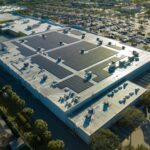Greening Cities: Phoenix Leads The Way with Nick Brown
Listen on your Preferred Podcast Player »
Sure, there are solar farms but have you encountered a solar city? That’s just what you will find in Phoenix. They are building parking lot carports that not only provide coveted shade for citizens but lay a foundation for a sort of inner-city solar farm. Additionally, they are utilizing many city-owned properties to harness clean energy to light up Sun Valley.
It’s a great pleasure to have guest Nick Brown, energy manager for the City of Phoenix, on Smart Energy Voices. In this episode, you’ll gain insights on the great strides made in buying clean energy and the strategies behind those purchases. Nick sat down with Smart Energy Decisions director of education programs Peter Kelly-Detweiler at the most recent Renewable Energy Sourcing Forum. You’ll appreciate and relate to Nick’s perspective on why his work in the energy sector is so important and meaningful.
You will want to hear this episode if you are interested in…
- Why Nick finds this to be one of the most fulfilling roles of his career [2:24]
- Why the carbon budget is imperative [5:11]
- Performance contracting using a qualified vendors list [7:59]
- Values beyond energy conservation [10:04]
- How big are the projects and how many are installed [12:43]
- Bigger utility-scale approaches when offsetting large amounts of energy [14:57]
- Advice for cities looking at decarbonization efforts like solar projects [17:14]
The dire circumstance we find ourselves in
The carbon budget is a much more dramatic issue than most people recognize, especially the general public. Whether you look at earth system models or integrated assessment models, the picture shows we only have 5 to 10 years of carbon budget remaining to stay within 1½° centigrade of global warming over preindustrial times. That’s dramatic. We’ve already burned half of what we might have because we didn’t have a cost on carbon 10 years back.
Over the last few months, we have reduced carbon emissions globally by about 6-8%. That sounds good, but we should recognize that we have not learned to be successful economically with that kind of reduction. Putting that in perspective, we will have to achieve that kind of reduction every year for the next decade to meet the target of 1½° or less of global warming. The reason for that target is that all of the natural catastrophes that have occurred over the past decade from 2010 to 2020 have cost three times more globally than the same kinds of catastrophes from 2000 to 2010. This is what’s already happened just with the carbon that’s in the air. It’s a fairly dire circumstance we find ourselves in.
Street solar and more efficient operations…
The City of Phoenix owns many properties across the Valley of the Sun such as water services, public works, parks, housing, neighborhood services, meeting facilities, the convention center, and, of course, the city’s airport, Sky Harbor. All of those facilities stand to benefit from reduced energy consumption. The city council has approved a $30 million investment in energy efficiency, which needs to precede renewable energy so the city can reduce its load first before moving to solar. That $30 million investment goes into performance contracting, which is moving aggressively with about $10 million currently under contract with ESCOs (energy services companies) as a precursor to the renewable energy program.
They also created a qualified vendors list (QVL) in 2018, which allows the city to potentially work with five approved companies during 2018- 2022. This eliminates requests for proposals each time a new project is developed. That’s been a real benefit to streamline the work and it keeps a lot of admin processes out of the way. Contract development is always extremely lengthy and complex so it’s a good thing to have contractors that are pre-qualified. It puts them on a fast track to accomplish projects faster and more efficiently.
Key points from a unique vantage point
Being on the board of the Salt River Project offers a unique vantage point in terms of understanding the logic of how things get done. Cities looking at decarbonization efforts such as solar projects— that don’t have the advantage of being on a board— should consider a couple of key points. One is understanding, participating, and being conversant with integrated resource planning (IRP). IRP processes are common to almost every utility to decide what a likely mix of different power supplies will be for the next 5-10 years. It determines which power stations are likely to carry the baseload and the peak load.
After an IRP process, it’s determined how each utility moves forward to provide power in their service area over the next few years. For those that want more renewable energy development for corporations or municipalities, there must be an understanding of how to integrate to have mutual success between developers and buyers. So it’s not something that can be figured out with a few meetings. Boards, executives, managers, and technologists will have to develop a keen capacity for integrating a resource planning process into their plans in ways that 10 or 15 years ago seemed not to be necessary at all.
Resources & People Mentioned
- City of Phoenix’s Sustainability Goals
Connect with Nick Brown
- Smart Energy Decisions
-
Follow us on LinkedIn
Subscribe to Smart Energy Voices on
Apple Podcasts, Google Podcasts, Android, Spotify, Stitcher, TuneIn Radio, aCast, PlayerFM, iHeart RadioIf you’re interested in participating in the next Smart Energy Decision Event, visit smartenergydecisions.com or email our Community Development team at [email protected]




